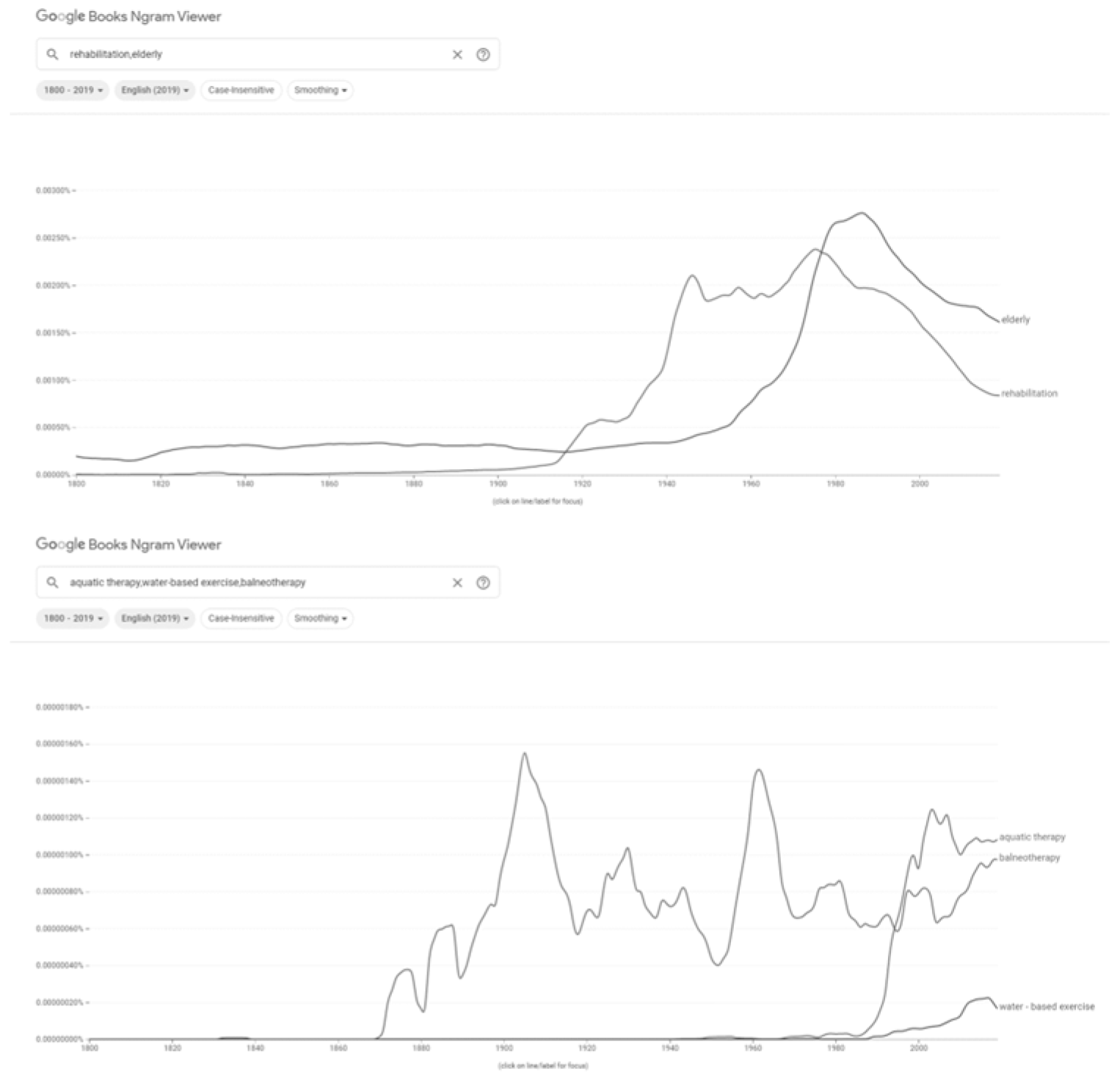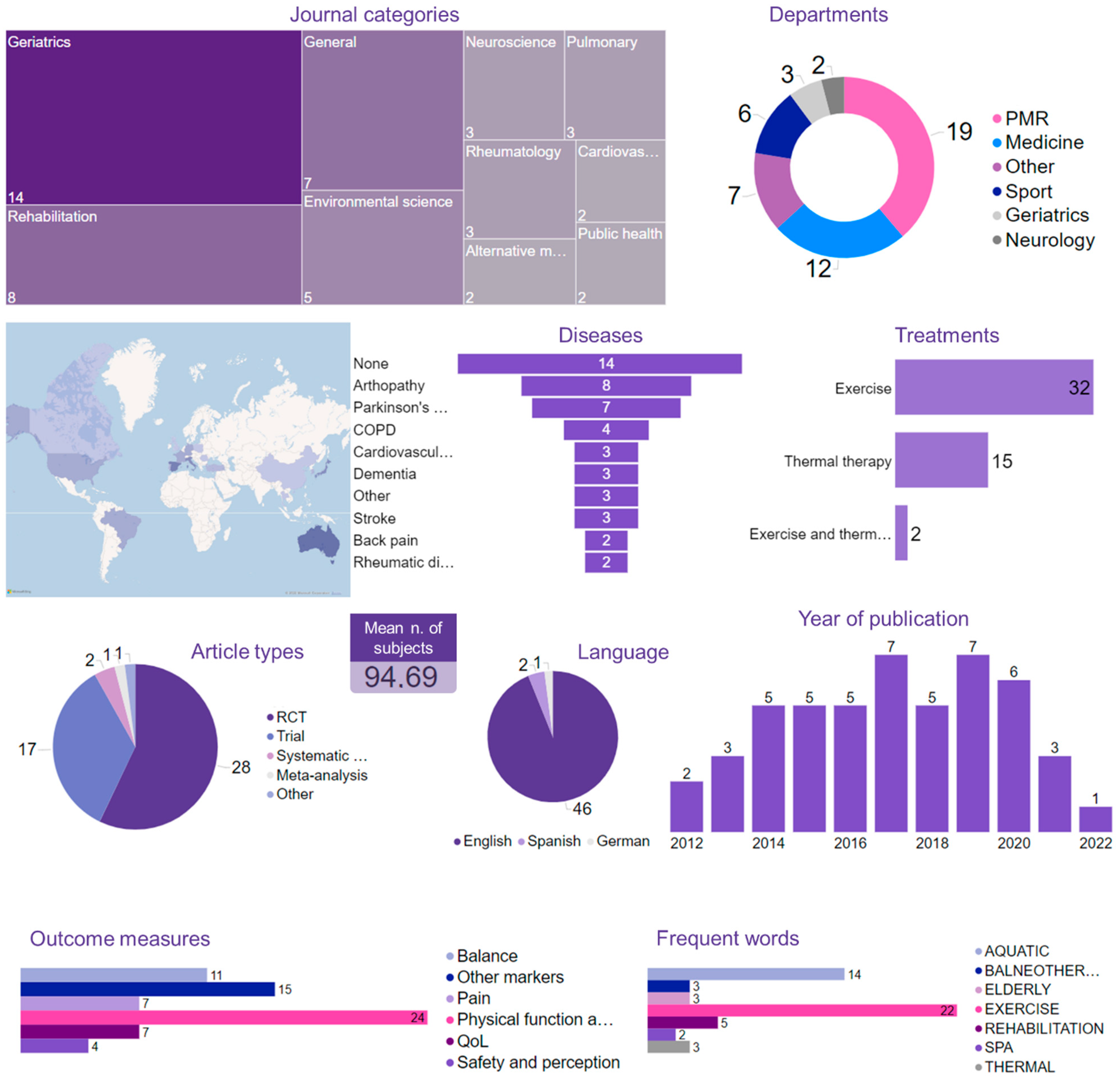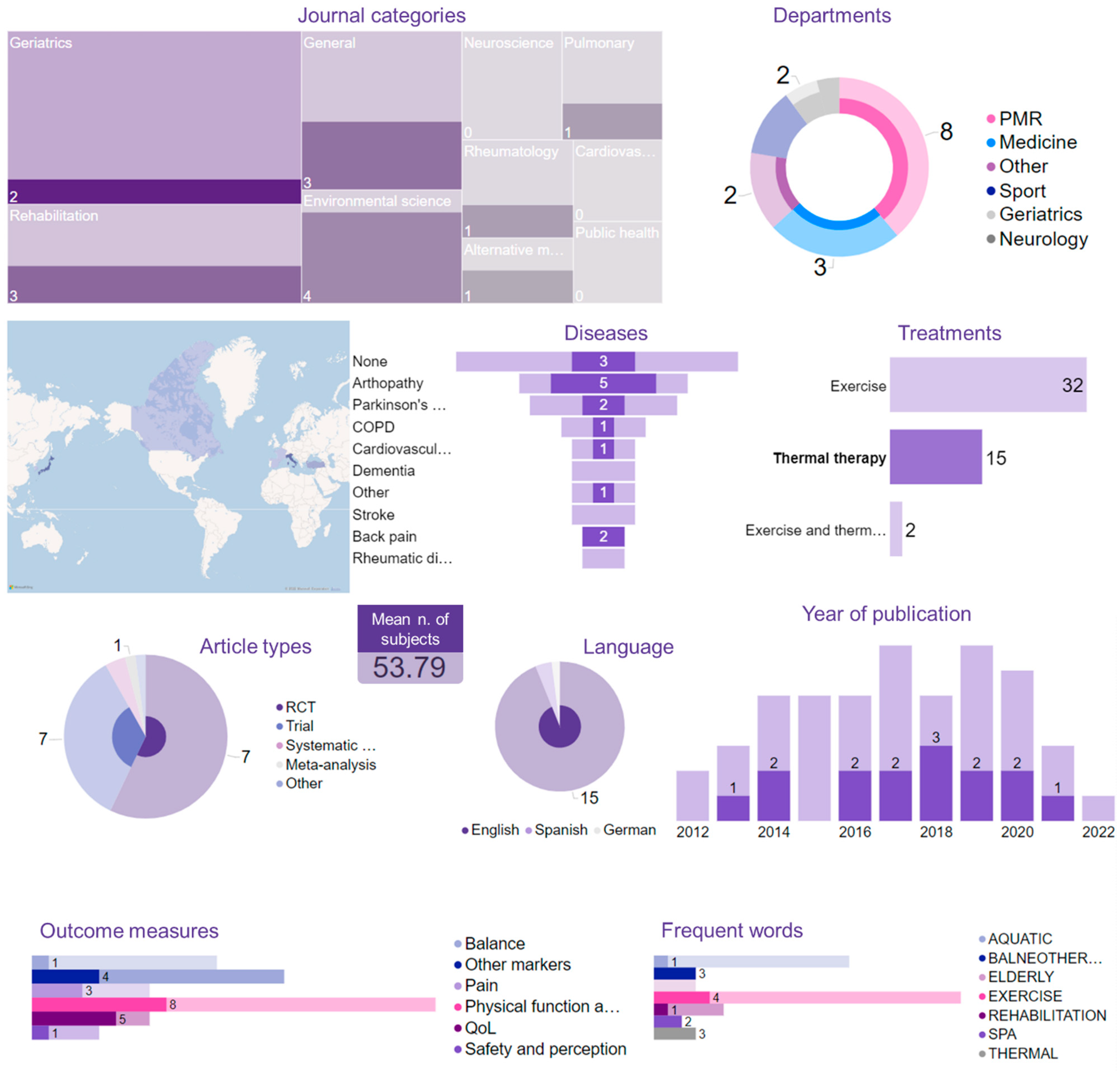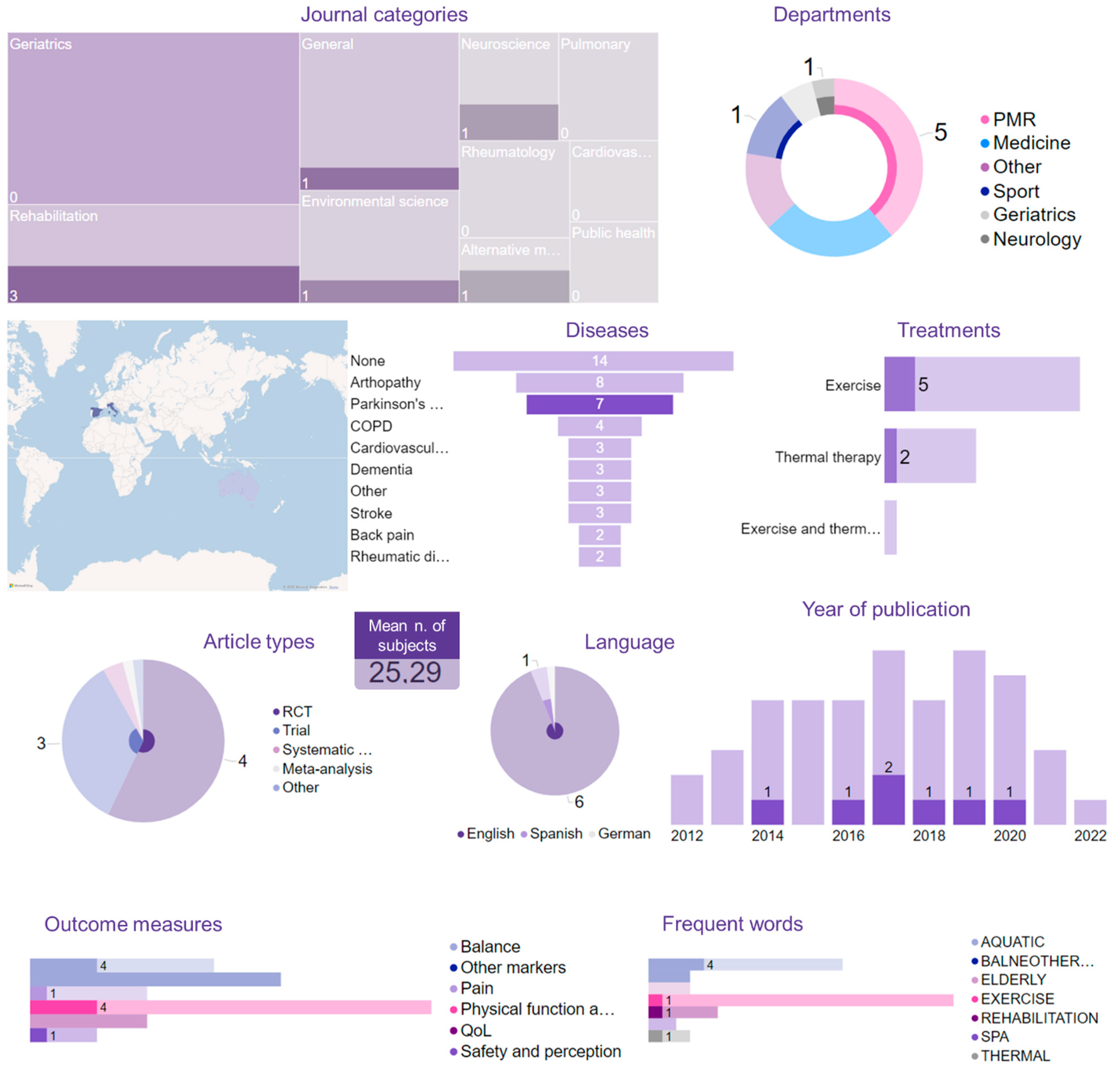Water-Based Rehabilitation in the Elderly: Data Science Approach to Support the Conduction of a Scoping Review
Abstract
Featured Application
Abstract
1. Introduction
2. Materials and Methods
3. Results
3.1. General Results
3.2. Relationships of the Variables
3.3. Limitations and Gaps in the Literature
4. Discussion
5. Conclusions
Author Contributions
Funding
Institutional Review Board Statement
Informed Consent Statement
Data Availability Statement
Conflicts of Interest
References
- McNeal, R.L. Aquatic therapy for patients with rheumatic disease. Rheum. Dis. Clin. N. Am. 1990, 16, 915–929. [Google Scholar] [CrossRef]
- Masiero, S.; Maghini, I.; Mantovani, M.E.; Bakdounes, L.; Koutsikos, K.; Del Felice, A.; Sale, P. Is the aquatic thermal environment a suitable place for providing rehabilitative treatment for person with Parkinson’s disease? A retrospective study. Int. J. Biometeorol. 2019, 63, 13–18. [Google Scholar] [CrossRef] [PubMed]
- Vinetti, G.; Ferretti, G.; Hostler, D. Effects of Water Immersion on the Internal Power of Cycling. Med. Sci. Sports Exerc. 2022, 54, 530–535. [Google Scholar] [CrossRef] [PubMed]
- Amara, S.; Barbosa, T.M.; Negra, Y.; Hammami, R.; Khalifa, R.; Chortane, S.G. The Effect of Concurrent Resistance Training on Upper Body Strength, Sprint Swimming Performance and Kinematics in Competitive Adolescent Swimmers. A Randomized Controlled Trial. Int. J. Environ. Res. Public Health 2021, 18, 10261. [Google Scholar] [CrossRef] [PubMed]
- Li, D.; Zhang, Q.; Liu, X.; Chen, C.; Lu, J.; Ye, D.; Li, Y.; Wang, W.; Shen, M. Effect of water-based walking exercise on rehabilitation of patients following ACL reconstruction: A prospective, randomised, single-blind clinical trial. Physiotherapy 2021, 115, 18–26. [Google Scholar] [CrossRef]
- Moini Jazani, A.; Ayati, M.H.; Nadiri, A.A.; Nasimi Doost Azgomi, R. Efficacy of hydrotherapy, spa therapy, and balneotherapy for psoriasis and atopic dermatitis: A systematic review. Int. J. Dermatol. 2022. early view. [Google Scholar] [CrossRef]
- Covill, L.G.; Utley, C.; Hochstein, C. Comparison of Ai Chi and Impairment-Based Aquatic Therapy for Older Adults with Balance Problems: A Clinical Study. J. Geriatr. Phys. Ther. 2017, 40, 204–213. [Google Scholar] [CrossRef]
- Izquierdo, M.; Merchant, R.A.; Morley, J.E.; Anker, S.D.; Aprahamian, I.; Arai, H.; Aubertin-Leheudre, M.; Bernabei, R.; Cadore, E.L.; Cesari, M.; et al. International Exercise Recommendations in Older Adults (ICFSR): Expert Consensus Guidelines. J. Nutr. Health Aging 2021, 25, 824–853. [Google Scholar] [CrossRef]
- Gálvez, I.; Torres-Piles, S.; Ortega, E. Innate/inflammatory bioregulation and clinical effectiveness of whole-body hyperthermia (balneotherapy) in elderly patients with osteoarthritis. Int. J. Hyperth. 2018, 35, 340–347. [Google Scholar] [CrossRef]
- Martínez-Carbonell Guillamón, E.; Burgess, L.; Immins, T.; Martínez-Almagro Andreo, A.; Wainwright, T.W. Does aquatic exercise improve commonly reported predisposing risk factors to falls within the elderly? A systematic review. BMC Geriatr. 2019, 19, 52. [Google Scholar] [CrossRef]
- Coraci, D.; Capobianco, S.V.; Romano, M.; Calvaruso, S.; Vecchio, M.; Giovannini, S.; Loreti, C.; Fusco, A.; Masiero, S.; Santilli, V.; et al. Neuropathic Pain and Ultrasonography: A Multiperspective Literature Evaluation. Diagnostics 2021, 11, 1705. [Google Scholar] [CrossRef] [PubMed]
- Hilary Arksey, H.; O’Malley, L. Scoping studies: Towards a methodological framework. Int. J. Soc. Res. Methodol. 2005, 8, 19–32. [Google Scholar] [CrossRef]
- Pham, M.T.; Rajić, A.; Greig, J.D.; Sargeant, J.M.; Papadopoulos, A.; McEwen, S.A. A scoping review of scoping reviews: Advancing the approach and enhancing the consistency. Res. Synth. Methods 2014, 5, 371–385. [Google Scholar] [CrossRef]
- Nussinov, R.; Jang, H.; Nir, G.; Tsai, C.J.; Cheng, F. Open Structural Data in Precision Medicine. Annu. Rev. Biomed. Data Sci. 2022, 5, 97–117. [Google Scholar] [CrossRef]
- Choudhury, T.; Arunachalam, R.; Khanna, A.; Jasinska, E.; Bolshev, V.; Panchenko, V.; Leonowicz, Z. A Social Network Analysis Approach to COVID-19 Community Detection Techniques. Int. J. Environ. Res. Public Health 2022, 19, 3791. [Google Scholar] [CrossRef] [PubMed]
- Farinha, C.; Santos, H.; Serrano, J.; Oliveiros, B.; Silva, F.M.; Cascante-Rusenhack, M.; Teixeira, A.M.; Ferreira, J.P. The Impact of Aquatic Exercise Programs on the Intima-Media thickness of the Carotid Arteries, Hemodynamic Parameters, Lipid Profile and Chemokines of Community-Dwelling Older Persons: A Randomized Controlled Trial. Int. J. Environ. Res. Public Health 2022, 19, 3377. [Google Scholar] [CrossRef]
- Pieniążek, M.; Mańko, G.; Spieszny, M.; Bilski, J.; Kurzydło, W.; Ambroży, T.; Jaszczur-Nowicki, J. Body Balance and Physiotherapy in the Aquatic Environment and at a Gym. Biomed. Res. Int. 2021, 2021, 9925802. [Google Scholar] [CrossRef]
- Campos, D.M.; Ferreira, D.L.; Gonçalves, G.H.; Farche, A.C.S.; de Oliveira, J.C.; Ansai, J.H. Effects of aquatic physical exercise on neuropsychological factors in older people: A systematic review. Arch. Gerontol. Geriatr. 2021, 96, 104435. [Google Scholar] [CrossRef]
- Ferreira, J.P.; Teixeira, A.; Serrano, J.; Farinha, C.; Santos, H.; Silva, F.M.; Cascante-Rusenhack, M.; Luís, P. Impact of Aquatic-Based Physical Exercise Programs on Risk Markers of Cardiometabolic Diseases in Older People: A Study Protocol for Randomized-Controlled Trials. Int. J. Environ. Res. Public Health 2020, 17, 8678. [Google Scholar] [CrossRef]
- Ma, T.; Song, X.; Ma, Y.; Hu, H.; Bai, H.; Li, Y.; Gao, L. The effect of thermal mineral waters on pain relief, physical function and quality of life in patients with osteoarthritis: A systematic review and meta-analysis. Medicine 2021, 100, e24488. [Google Scholar] [CrossRef]
- Sugie, M.; Harada, K.; Takahashi, T.; Nara, M.; Fujimoto, H.; Kyo, S.; Ito, H. Effectiveness of a far-infrared low-temperature sauna program on geriatric syndrome and frailty in community-dwelling older people. Geriatr. Gerontol. Int. 2020, 20, 892–898. [Google Scholar] [CrossRef] [PubMed]
- Terrens, A.F.; Soh, S.E.; Morgan, P. The safety and feasibility of a Halliwick style of aquatic physiotherapy for falls and balance dysfunction in people with Parkinson’s Disease: A single blind pilot trial. PLoS ONE 2020, 15, e0236391. [Google Scholar] [CrossRef]
- Nissim, M.; Livny, A.; Barmatz, C.; Tsarfaty, G.; Berner, Y.; Sacher, Y.; Giron, J.; Ratzon, N.Z. Effects of aquatic physical intervention on fall risk, working memory and hazard-perception as pedestrians in older people: A pilot trial. BMC Geriatr. 2020, 20, 74. [Google Scholar] [CrossRef]
- Kang, D.W.; Bressel, E.; Kim, D.Y. Effects of aquatic exercise on insulin-like growth factor-1, brain-derived neurotrophic factor, vascular endothelial growth factor, and cognitive function in elderly women. Exp. Gerontol. 2020, 132, 110842. [Google Scholar] [CrossRef] [PubMed]
- Masiero, S.; Pranovi, G.; Di Pumpo, M.; Bernardini, S.; Dattilo, A.; Del Felice, A.; Sale, P. Does aquatic thermal therapy improve quality of life after total hip replacement? A retrospective preliminary pilot study. Int. J. Biometeorol. 2020, 64, 1023–1026. [Google Scholar] [CrossRef] [PubMed]
- Kittichaikarn, C.; Kuptniratsaikul, V. Design of an Underwater Treadmill System for rehabilitation of older obese adults: A pre-post study. BMC Geriatr. 2019, 19, 310. [Google Scholar] [CrossRef]
- Iwasaka, C.; Sakamoto, M.; Mitsutake, T.; Horikawa, E. Effects of a water-based exercise program on disability prevention in older Japanese adults. Geriatr. Gerontol. Int. 2019, 19, 1282–1288. [Google Scholar] [CrossRef]
- Sosner, P.; Gayda, M.; Dupuy, O.; Garzon, M.; Gremeaux, V.; Lalongé, J.; Hayami, D.; Juneau, M.; Nigam, A.; Bosquet, L. Ambulatory blood pressure reduction following 2 weeks of high-intensity interval training on an immersed ergocycle. Arch. Cardiovasc. Dis. 2019, 112, 680–690. [Google Scholar] [CrossRef]
- Gravel, H.; Coombs, G.B.; Behzadi, P.; Marcoux-Clément, V.; Barry, H.; Juneau, M.; Nigam, A.; Gagnon, D. Acute effect of Finnish sauna bathing on brachial artery flow-mediated dilation and reactive hyperemia in healthy middle-aged and older adults. Physiol. Rep. 2019, 7, e14166. [Google Scholar] [CrossRef]
- Silva, L.A.D.; Tortelli, L.; Motta, J.; Menguer, L.; Mariano, S.; Tasca, G.; Silveira, G.B.; Pinho, R.A.; Silveira, P.C.L. Effects of aquatic exercise on mental health, functional autonomy and oxidative stress in depressed elderly individuals: A randomized clinical trial. Clinics 2019, 74, e322. [Google Scholar] [CrossRef]
- Uivarosan, D.; Tit, D.M.; Iovan, C.; Nistor-Cseppento, D.C.; Endres, L.; Lazar, L.; Sava, C.; Sabau, A.M.; Buhas, C.; Moleriu, L.C.; et al. Effects of combining modern recovery techniques with neurotrophic medication and standard treatment in stroke patients. Sci. Total Environ. 2019, 679, 80–87. [Google Scholar] [CrossRef] [PubMed]
- Wu, W.; Liu, X.; Liu, J.; Li, P.; Wang, Z. Effectiveness of water-based Liuzijue exercise on respiratory muscle strength and peripheral skeletal muscle function in patients with COPD. Int. J. Chronic Obstr. Pulm. Dis. 2018, 13, 1713–1726. [Google Scholar] [CrossRef] [PubMed]
- Musumeci, A.; Pranovi, G.; Masiero, S. Patient education and rehabilitation after hip arthroplasty in an Italian spa center: A pilot study on its feasibility. Int. J. Biometeorol. 2018, 62, 1489–1496. [Google Scholar] [CrossRef] [PubMed]
- Pérez-de la Cruz, S. A bicentric controlled study on the effects of aquatic Ai Chi in Parkinson disease. Complement. Ther. Med. 2018, 36, 147–153. [Google Scholar] [CrossRef]
- Chary-Valckenaere, I.; Loeuille, D.; Jay, N.; Kohler, F.; Tamisier, J.N.; Roques, C.F.; Boulange, M.; Gay, G. Spa therapy together with supervised self-mobilisation improves pain, function and quality of life in patients with chronic shoulder pain: A single-blind randomised controlled trial. Int. J. Biometeorol. 2018, 62, 1003–1014. [Google Scholar] [CrossRef]
- Morer, C.; Boestad, C.; Zuluaga, P.; Alvarez-Badillo, A.; Maraver, F. Effects of an intensive thalassotherapy and aquatic therapy program in stroke patients. A pilot study. Rev. Neurol. 2017, 65, 249–256. [Google Scholar]
- Henwood, T.; Neville, C.; Baguley, C.; Beattie, E. Aquatic exercise for residential aged care adults with dementia: Benefits and barriers to participation. Int. Psychogeriatr. 2017, 29, 1439–1449. [Google Scholar] [CrossRef]
- Kutzner, I.; Richter, A.; Gordt, K.; Dymke, J.; Damm, P.; Duda, G.N.; Günzl, R.; Bergmann, G. Does aquatic exercise reduce hip and knee joint loading? In vivo load measurements with instrumented implants. PLoS ONE 2017, 12, e0171972. [Google Scholar] [CrossRef]
- Palamara, G.; Gotti, F.; Maestri, R.; Bera, R.; Gargantini, R.; Bossio, F.; Zivi, I.; Volpe, D.; Ferrazzoli, D.; Frazzitta, G. Land Plus Aquatic Therapy Versus Land-Based Rehabilitation Alone for the Treatment of Balance Dysfunction in Parkinson Disease: A Randomized Controlled Study With 6-Month Follow-Up. Arch. Phys. Med. Rehabil. 2017, 98, 1077–1085. [Google Scholar] [CrossRef]
- Kavadar, G.; Demircioğlu, D.T.; Can, H.; Emre, T.Y.; Civelek, E.; Senyigit, A. The clinical factors associated with benefit finding of complementary medicine use in patients with back pain: A cross-sectional study with cluster analysis. J. Back Musculoskelet. Rehabil. 2017, 30, 271–277. [Google Scholar] [CrossRef]
- Volpe, D.; Giantin, M.G.; Manuela, P.; Filippetto, C.; Pelosin, E.; Abbruzzese, G.; Antonini, A. Water-based vs. non-water-based physiotherapy for rehabilitation of postural deformities in Parkinson’s disease: A randomized controlled pilot study. Clin. Rehabil. 2017, 31, 1107–1115. [Google Scholar] [CrossRef] [PubMed]
- Kim, H.J.; Lee, Y.; Sohng, K.Y. The effects of footbath on sleep among the older adults in nursing home: A quasi-experimental study. Complement. Ther. Med. 2016, 26, 40–46. [Google Scholar] [CrossRef] [PubMed]
- Barker, A.L.; Talevski, J.; Morello, R.T.; Nolan, G.A.; De Silva, R.D.; Briggs, A.M. Jumping into the deep-end: Results from a pilot impact evaluation of a community-based aquatic exercise program. Clin. Rheumatol. 2016, 35, 1593–1601. [Google Scholar] [CrossRef] [PubMed][Green Version]
- Pérez-de la Cruz, S.; García Luengo, A.V.; Lambeck, J. Effects of an Ai Chi fall prevention programme for patients with Parkinson’s disease. Neurologia 2016, 31, 176–182. [Google Scholar] [CrossRef]
- Noack, F.; Schmidt, B.; Amoury, M.; Stoevesandt, D.; Gielen, S.; Pflaumbaum, B.; Girschick, C.; Völler, H.; Schlitt, A. Feasibility and safety of rehabilitation after venous thromboembolism. Vasc. Health Risk Manag. 2015, 11, 397–401. [Google Scholar] [CrossRef]
- Haseba, S.; Sakakima, H.; Kubozono, T.; Nakao, S.; Ikeda, S. Combined effects of repeated sauna therapy and exercise training on cardiac function and physical activity in patients with chronic heart failure. Disabil. Rehabil. 2016, 38, 409–415. [Google Scholar] [CrossRef]
- Cancela, J.M.; Suárez, M.H.V.; Vasconcelos, J.; Lima, A.; Ayán, C. Efficacy of Brain Gym Training on the Cognitive Performance and Fitness Level of Active Older Adults: A Preliminary Study. J. Aging Phys. Act. 2015, 23, 653–658. [Google Scholar] [CrossRef]
- Fedor, A.; Garcia, S.; Gunstad, J. The effects of a brief, water-based exercise intervention on cognitive function in older adults. Arch. Clin. Neuropsychol. 2015, 30, 139–147. [Google Scholar] [CrossRef][Green Version]
- McNamara, R.J.; McKeough, Z.J.; McKenzie, D.K.; Alison, J.A. Acceptability of the aquatic environment for exercise training by people with chronic obstructive pulmonary disease with physical comorbidities: Additional results from a randomised controlled trial. Physiotherapy 2015, 101, 187–192. [Google Scholar] [CrossRef]
- Nishiyori, R.; Lai, B.; Lee, D.K.; Vrongistinos, K.; Jung, T. The Use of Cuff Weights for Aquatic Gait Training in People Post-Stroke with Hemiparesis. Physiother. Res. Int. 2016, 21, 47–53. [Google Scholar] [CrossRef]
- Henwood, T.; Neville, C.; Baguley, C.; Clifton, K.; Beattie, E. Physical and functional implications of aquatic exercise for nursing home residents with dementia. Geriatr. Nurs. 2015, 36, 35–39. [Google Scholar] [CrossRef] [PubMed]
- De Oliveira, M.R.; da Silva, R.A.; Dascal, J.B.; Teixeira, D.C. Effect of different types of exercise on postural balance in elderly women: A randomized controlled trial. Arch. Gerontol. Geriatr. 2014, 59, 506–514. [Google Scholar] [CrossRef] [PubMed]
- Onat, Ş.Ş.; Taşoğlu, Ö.; Güneri, F.D.; Özişler, Z.; Safer, V.B.; Özgirgin, N. The effectiveness of balneotherapy in chronic low back pain. Clin. Rheumatol. 2014, 33, 1509–1515. [Google Scholar] [CrossRef] [PubMed]
- Neville, C.; Henwood, T.; Beattie, E.; Fielding, E. Exploring the effect of aquatic exercise on behaviour and psychological well-being in people with moderate to severe dementia: A pilot study of the Watermemories Swimming Club. Australas. J. Ageing 2014, 33, 124–127. [Google Scholar] [CrossRef]
- Kikuchi, H.; Shiozawa, N.; Takata, S.; Ashida, K.; Mitsunobu, F. Effect of repeated Waon therapy on exercise tolerance and pulmonary function in patients with chronic obstructive pulmonary disease: A pilot controlled clinical trial. Int. J. Chronic Obstr. Pulm. Dis. 2014, 9, 9–15. [Google Scholar] [CrossRef][Green Version]
- Ayán, C.; Cancela, J.M.; Gutiérrez-Santiago, A.; Prieto, I. Effects of two different exercise programs on gait parameters in individuals with Parkinson’s disease: A pilot study. Gait Posture 2014, 39, 648–651. [Google Scholar] [CrossRef]
- Sakurai, R.; Fujiwara, Y.; Saito, K.; Fukaya, T.; Kim, M.J.; Yasunaga, M.; Kim, H.; Ogawa, K.; Tanaka, C.; Tsunoda, N.; et al. Effects of a comprehensive intervention program, including hot bathing, on overweight adults: A randomized controlled trial. Geriatr. Gerontol. Int. 2013, 13, 638–645. [Google Scholar] [CrossRef]
- McNamara, R.J.; McKeough, Z.J.; McKenzie, D.K.; Alison, J.A. Water-based exercise in COPD with physical comorbidities: A randomised controlled trial. Eur. Respir. J. 2013, 41, 1284–1291. [Google Scholar] [CrossRef]
- Al-Qubaeissy, K.Y.; Fatoye, F.A.; Goodwin, P.C.; Yohannes, A.M. The effectiveness of hydrotherapy in the management of rheumatoid arthritis: A systematic review. Musculoskelet. Care 2013, 11, 3–18. [Google Scholar] [CrossRef]
- Hardt, R. Special features of physical therapy for elderly rheumatic patients. Z. Rheumatol. 2012, 71, 396–402. [Google Scholar] [CrossRef]
- Bento, P.C.B.; Pereira, G.; Ugrinowitsch, C.; Rodacki, A.L.F. The effects of a water-based exercise program on strength and functionality of older adults. J. Aging Phys. Act. 2012, 20, 469–483. [Google Scholar] [CrossRef] [PubMed]
- Berková, M.; Berka, Z. Falls: A significant cause of morbidity and mortality in elderly people. Vnitr. Lek. 2018, 64, 1076–1083. [Google Scholar] [CrossRef] [PubMed]
- Kang, H.; Kim, H. Ageism and Psychological Well-Being Among Older Adults: A Systematic Review. Gerontol. Geriatr. Med. 2022, 8, 23337214221087023. [Google Scholar] [CrossRef] [PubMed]





| Authors | Numb. of Patients | Disease | Main Treatment | Main Assessment Scales |
|---|---|---|---|---|
| Farinha et al., 2022 [16] | 102 | Water-based exercise | Other markers | |
| Pieniążek et al., 2021 [17] | 137 | Other | Water-based exercise | Balance |
| Campos et al., 2021 [18] | 1707 | Water-based exercise | Other markers | |
| Ferreira et al., 2020 [19] | Water-based exercise | Other markers | ||
| Ma et al., 2021 [20] | Arthopathy | Thermal therapy | Pain; physical function and muscle strength; QoL | |
| Sugie et al., 2020 [21] | 67 | Other | Thermal therapy | Physical function and muscle strength |
| Terrens et al., 2020 [22] | 30 | Parkinson’s disease | Water-based exercise | Safety and perception |
| Nissim et al., 2020 [23] | 42 | Water-based exercise | Balance; pther markers | |
| Kang et al., 2020 [24] | 20 | Water-based exercise | Other markers | |
| Masiero et al., 2020 [25] | 11 | Arthopathy | Thermal therapy | QoL |
| Kittichaikarn and Kuptniratsaikul, 2019 [26] | 30 | Arthopathy | Water-based exercise | Pain; physical function and muscle strength |
| Iwasaka et al., 2019 [27] | 278 | Water-based exercise | Physical function and muscle strength | |
| Sosner et al., 2019 [28] | 42 | Cardiovascular disease | Water-based exercise | Other markers |
| Gravel et al., 2019 [29] | 21 | Thermal therapy | Other markers | |
| Silva et al., 2019 [30] | 92 | Other | Water-based exercise | Balance; other markers |
| Uivarosan et al., 2019 [31] | 70 | Stroke | Water-based exercise and thermal therapy | Physical function and muscle strength |
| Masiero et al., 2019 [2] | 14 | Parkinson’s disease | Thermal therapy | Balance |
| Gálvez et al., 2018 [9] | 36 | Arthopathy | Thermal therapy | Pain; physical function and muscle strength; QoL |
| Wu et al., 2018 [32] | 50 | COPD | Water-based exercise | Physical function and muscle strength |
| Musumeci et al., 2018 [33] | 12 | Arthopathy | Thermal therapy | Physical function and muscle strength; QoL |
| Pérez-de la Cruz, 2018 [34] | 29 | Parkinson’s disease | Water-based exercise | Physical function and muscle strength; balance |
| Chary-Valckenaere et al., 2018 [35] | 186 | Arthopathy | Thermal therapy | Physical function and muscle strength |
| Morer et al., 2017 [36] | 26 | Stroke | Water-based exercise | Physical function and muscle strength; balance |
| Henwood et al., 2017 [37] | 46 | Dementia | Water-based exercise | Other markers |
| Kutzner et al., 2017 [38] | 12 | Arthopathy | Water-based exercise | Physical function and muscle strength |
| Palamara et al., 2017 [39] | 34 | Parkinson’s disease | Water-based exercise | Balance |
| Kavadar et al., 2017 [40] | 155 | Back pain | Thermal therapy | Safety and perception |
| Volpe et al., 2017 [41] | 30 | Parkinson’s disease | Thermal therapy | Physical function and muscle strength |
| Kim et al., 2016 [42] | 30 | Thermal therapy | Other markers | |
| Barker et al., 2016 [43] | 151 | Arthopathy | Water-based exercise | Pain; physical function and muscle strength; QoL |
| Pérez-de la Cruz et al., 2016 [44] | 15 | Parkinson’s disease | Water-based exercise | Pain; physical function and muscle strength; balance |
| Noack et al., 2015 [45] | 169 | Cardiovascular disease | Water-based exercise | Safety and perception |
| Haseba et al., 2016 [46] | 24 | Cardiovascular disease | Thermal therapy | Other markers |
| Cancela et al., 2015 [47] | 85 | Water-based exercise | Physical function and muscle strength | |
| Fedor et al., 2015 [48] | 60 | Water-based exercise | Other markers | |
| McNamara et al., 2015 [49] | 18 | COPD | Water-based exercise | Safety and perception |
| Nishiyori et al., 2016 [50] | 21 | Stroke | Water-based exercise | Physical function and muscle strength |
| Henwood et al., 2015 [51] | 10 | Dementia | Water-based exercise | Physical function and muscle strength |
| de Oliveira et al., 2014 [52] | 74 | Water-based exercise | Balance | |
| Onat et al., 2014 [53] | 81 | Back pain | Thermal therapy | Pain; physical function and muscle strength; QoL |
| Neville et al., 2014 [54] | 11 | Dementia | Water-based exercise | Physical function and muscle strength; balance; other markers |
| Kikuchi et al., 2014 [55] | 20 | COPD | Thermal therapy | Other markers |
| Ayán et al., 2014 [56] | 25 | Parkinson’s disease | Water-based exercise | Physical function and muscle strength |
| Sakurai et al., 2013 [57] | 66 | Thermal therapy | Physical function and muscle strength | |
| McNamara et al., 2013 [58] | 53 | COPD | Water-based exercise | Physical function and muscle strength |
| Al-Qubaeissy et al., 2013 [59] | Rheumatic disease | Water-based exercise | Pain; QoL | |
| Hardt, 2012 [60] | Rheumatic disease | Water-based exercise and thermal therapy | Other markers | |
| Bento et al., 2012 [61] | 37 | Water-based exercise | Physical function and muscle strength |
Publisher’s Note: MDPI stays neutral with regard to jurisdictional claims in published maps and institutional affiliations. |
© 2022 by the authors. Licensee MDPI, Basel, Switzerland. This article is an open access article distributed under the terms and conditions of the Creative Commons Attribution (CC BY) license (https://creativecommons.org/licenses/by/4.0/).
Share and Cite
Coraci, D.; Tognolo, L.; Maccarone, M.C.; Santilli, G.; Ronconi, G.; Masiero, S. Water-Based Rehabilitation in the Elderly: Data Science Approach to Support the Conduction of a Scoping Review. Appl. Sci. 2022, 12, 8999. https://doi.org/10.3390/app12188999
Coraci D, Tognolo L, Maccarone MC, Santilli G, Ronconi G, Masiero S. Water-Based Rehabilitation in the Elderly: Data Science Approach to Support the Conduction of a Scoping Review. Applied Sciences. 2022; 12(18):8999. https://doi.org/10.3390/app12188999
Chicago/Turabian StyleCoraci, Daniele, Lucrezia Tognolo, Maria Chiara Maccarone, Gabriele Santilli, Gianpaolo Ronconi, and Stefano Masiero. 2022. "Water-Based Rehabilitation in the Elderly: Data Science Approach to Support the Conduction of a Scoping Review" Applied Sciences 12, no. 18: 8999. https://doi.org/10.3390/app12188999
APA StyleCoraci, D., Tognolo, L., Maccarone, M. C., Santilli, G., Ronconi, G., & Masiero, S. (2022). Water-Based Rehabilitation in the Elderly: Data Science Approach to Support the Conduction of a Scoping Review. Applied Sciences, 12(18), 8999. https://doi.org/10.3390/app12188999









